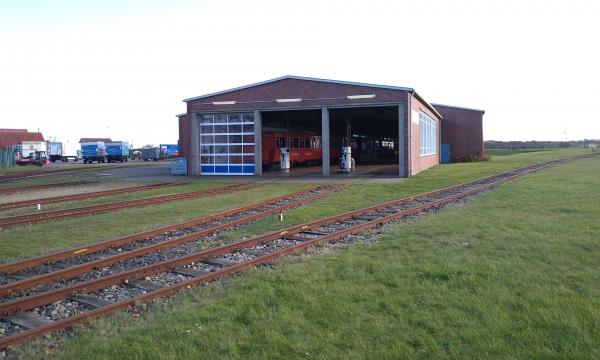
You are here
Chair of Electric Railways
Study by transport scientists from the TU Dresden on the Langeoog island railway gives recommendations for more environmentally friendly propulsion technology.
How can diesel-powered railway lines be operated in the future regarding climate protection and sustainability? This question was addressed by the railway operation of the North Sea island of Langeoog and transport scientists from the TU Dresden.
The island of Langeoog represents an interesting case in terms of transport. It is only accessible to visitors by boat and plane. With a few exceptions (electric vehicles and trailers), only the island railway, bicycles and carriages travel on the island. The ships and the railway are powered by diesel engines. The engines of the island railway's traction units have been in use since 1995. Time to "retire" them or at least give them a thorough overhaul. But which drive technology should follow?
In order to answer this question or to receive well-founded recommendations, the island administration contacted the transport sciences department of the TU Dresden - specifically the Chair of Electric Railways headed by Prof. Arnd Stephan. The team was commissioned by the island municipality to examine a conversion to possible alternative environmentally friendly drive technologies.
First stocktaking: island railway as a lifeline
A business trip including an initial discussion and review of the conditions on Langeoog took place in November 2021. It was important for the participating research assistants Tobias Bregulla and Nyascha Thomas Wittemann to gain an overview of the infrastructural, operational, technical and environmental conditions on Langeoog. Aspects such as nature conservation areas or possible flooding of the harbour area had to be taken into account. The aim of the study was to maintain the status quo as far as possible, especially because of the wagons that could still be used for many years to come, and to find an operationally feasible drive solution for this, because the island railway forms the main traffic and lifeline of the island, especially for tourism. In addition, the ideas of the clients and existing documents (consumption data, timetable, vehicle plans) were included in the further procedure.

Battery or hydrogen drive? A question of economic efficiency too!
After this initial stocktaking, the next step was to examine alternative forms of propulsion to the diesel engine. These included hydrogen, more environmentally friendly synthetic fuels or battery operation. A conventional electric solution with an overhead line is not feasible due to the island's conditions, e.g., nature conservation. A hydrogen-powered solution was ruled out after a thorough investigation because it was uneconomical.
For all the possibilities examined, it was important to consider current vehicle equipment (e.g. heating and control of the carriages) and to subject possible adaptations of the technology to a test by a manufacturing company.
Subsequently, the transport scientists created various simulations to better capture the actual direct diesel consumption. A designed driving dynamics simulation was used, for example, to calculate a possible battery (size, energy requirement) that also covers the heating of the carriage train and the lighting. In addition, the question was whether a complete new acquisition should be made or only a conversion of the existing traction units.
After completion of all investigations and their evaluation, the TUD scientists recommended a battery-electric variant as the preferred solution to the railway and island management, also because it turned out to be the most suitable from the emission, operational and economic aspects.
Special research location as a challenge
For graduate engineer Tobias Bregulla, the Langeoog island railway was "a new, appealing and exciting project". An island, for example, is a rather untypical research location. "Also, the change from the 'big railway' research field to a small specialised field like an island railway required a rethink. We had to adapt our normal approach to such appraisals to island railway conditions." A particular challenge for the scientists was reconciling the existing locomotives' high diesel consumption values with the expectation. It turned out that the measured high diesel consumption in the existing stock was mainly due to the efficiency of the powerful diesel engines, which could be improved. Due to the slow travel and the track, they are always operated only in the lower partial load range and mostly cold. Ultimately, the TUD team determined that the existing drive system is oversized for daily operation and that only an electric drive can really improve this aspect.
Originalautor
Further research projects of the Chair of Electric Railways
In addition to the Langeoog Island Railway Project, the Chair of Electric Railways has other exciting research topics and fields. These include projects on conventional and alternative drives as well as research on vehicle technology and the control of hybrid vehicles.
About the Langeoog island railway
The Langeoog island railway was first put into operation in 1937 and was previously a horse-drawn railway. It runs along a 2.6 km route and connects the island's ferry port with the village of Langeoog. Since 2008, the island railway has been used exclusively for passenger transport.
In the 1990s, a number of modernisation measures were carried out. These include the construction of a new station building, the procurement of completely new train sets, the repair of the tracks and the platform, as well as a changed road layout in the immediate vicinity.
Contact
Dipl.-Ing. Tobias Bregulla
Research Assistant
Chair of Electric Railways
"Friedrich List" Faculty of Transport and Traffic Science, TU Dresden
Mail: tobias.bregulla@tu-dresden.de
The Langeoog island railway runs a
2.6 km
long route and connects the island's ferry port with the village of Langeoog.
